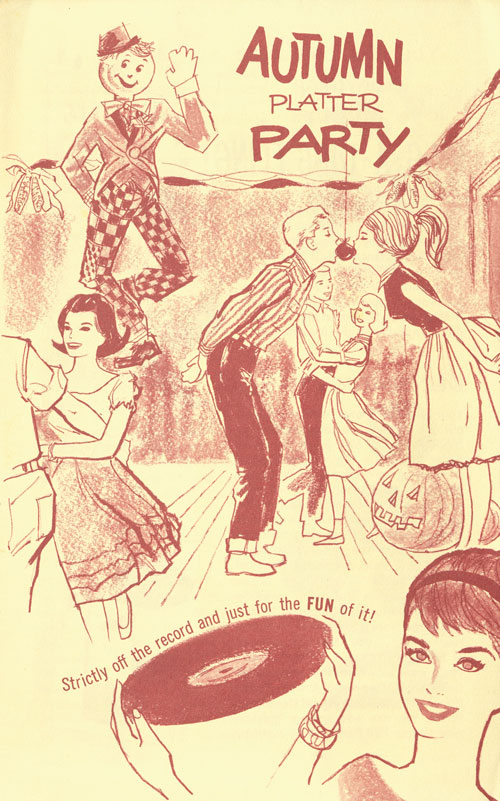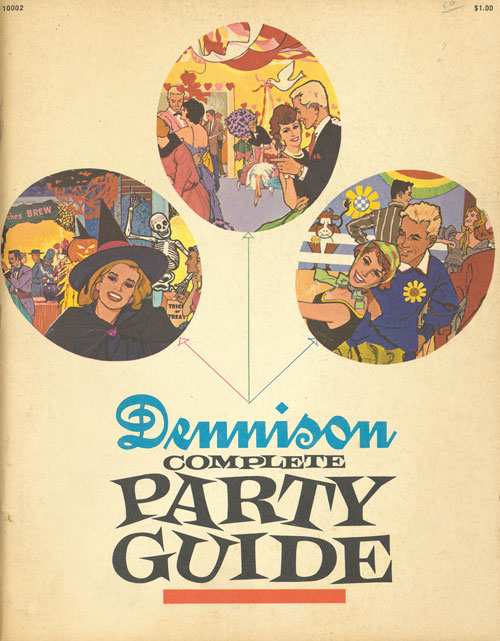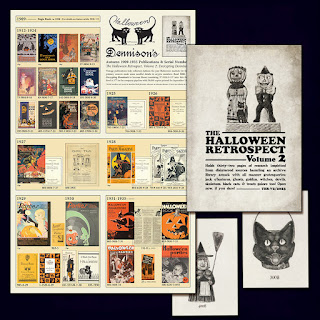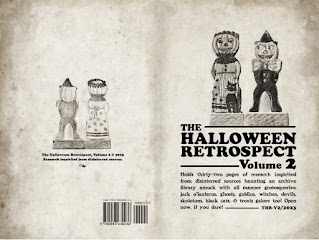Retro Fab Halloween:
Wonder what great references exist for the vintage collectibles of Dennison's vintage ephemera? I often find it's best to look back at some of the original material of the era, and collectors are lucky that Dennison produced a ton of promotional material we can use today as primary sources.
Yes, in it's day, Dennison publishes a long string of annual Halloween-devoted books to help sell their products - from the
Bogie Book of the 1910-1920's, to the later 1920's Halloween-themed editions of
Parties and
Party Magazine, to the somewhat strained hurrahs in the 1930's with seasonal titles like
The Halloween Book (see
Dennison Halloween Number). And the company kept active well into the mid-century and beyond. However, for collectible guidebook
The Halloween Retrospect, Volume 2 a cut-off date was necessary to fit contents of an 11"x17" fold-out poster: "Dennison's Halloween 1909-1935 Autumn Publications & Serial Numbers" (see below).
Dennison Complete Party Guide (c) 1961 from
The Halloween Retrospect archive library collection.

Dennison Gallery of vintage Halloween collectibles publications.
Since not every later-era publication could fit, it seems the fun mid-century out-takes need some amount of representation, and are shared here on the blog space. Here's a few extras you might enjoy:
Check out this pamphlet from around the fifties or sixties. Perhaps, you remember that jointed scarecrow figure from the Dennison product line? It is known to have appeared in their 1966 price list (although maybe earlier and/or later). Unfortunately, the serial number system (that is so consistent on items included on the poster) is missing on many titles in the later century. Do you have the definite records for the years of that scarecrow decoration?
 Autumn Platter Party - four page brochure.
Autumn Platter Party - four page brochure.
Next, is a book with colorful illustrations, like that shown as the banner of this blog entry. Notice that moveable skeleton in the background at the Halloween party! This decoration is known to appear in product catalogs 1959, 1961, 1970 (although earlier or later is perhaps possible). Do you know the years for certain? As earlier noted - while the THR article and poster offers consistent advice on serial number translation - the system falls apart in later years, so the curious numbers appearing here such as 10002 (on front) and No. 559 (on back) are not entirely clear, however the copyright date is 1961.
Complete Party Guide - for all occasions.
Serial Numbers:
Vintage Halloween collectible guidebook: THR-V2
In other words --- the poster above shows a selection of book covers. Below them, the archivist librarian has reprinted any visible serial numbers from those titles. With that serial number, a person can tell —- 1) at what point the publication fell in line with any others, 2) how many were printed (which can be amazingly high!), and 3) finer specifics about the month and year. "Decrypting Dennison: Serial Number Guide Featuring Autumn Publications" is written with great detail, so readers comprehend the complexity of finding the solution.
The Halloween Retrospect Vol 2, shown here as sample pages
featuring Dennison, Shackman, Rosen, & German imports.

The Halloween Retrospect, Volume 2 (cover, two Shackman
novelty postcards, and Dennison Halloween poster).
It is my wish as author, editor, collector, archivist, librarian, artist, designer, publisher, and seller, that you too enjoy the type of publication I wanted to see and share. In addition to the Dennison article,
The Halloween Retrospect, Volume 2 also has bits about B. Shackman (w/insert cards), E. Rosen Company, and a look at the German couple on the cover. For the table of contents see the
publications section of The Halloween Retrospect website.
Cover art for The Halloween Retrospect, Volume 2
The 6"x9" 32-page booklet offers visuals with explanatory text particularly focusing on sources (as the main point of the series) so you get transparency (something other survey books often do not provide). To achieve this, THR refers currently to 525+ catalogs of physical copies on shelf in the archive library. Yet, in the most recent edition has worked with another archive to expand sources! Read on...
Dennison Archives:
Framingham History Center (logo).
As I have said before sources matter if you are going to believe what someone says about vintage Halloween collectibles. To review, THR volumes are about details and sources! This means content has a research-emphasis with detailed notes and citations.
Research for the Dennison article begins by contacting Nancy Prince (@dennisonarchivist) who recently completed an accessible trove of Dennison information housed at Framingham History Center. From then on, the author's research continues during 2023, with her help, as hours are spent tracking down 200-/+ Dennison titles - to record their serial numbers. To support this, there are additional discoveries of documents that confirm theories surrounding the numbers (which you can view in the article).
While most, if not all, Dennison publications for THR, V2. book and poster come from THR’s archive library – the author once again thanks Framingham History Center, and Dennison collection organizer Nancy Prince (@dennisonarchivist) for creating a discoverable and accessible archive – that verifies conclusions in the new book! For more on those archive see Framingham History Center To Unveil Dennison Manufacturing Company Exhibit (C. Frary, 11- 21-2014). And, if you are a researcher seeking more on Dennison, there are two locations of documentation. First, there is the Dennison Manufacturing Company Archives, 1844-1990 that is composed of 273 archival boxes. Second, there is the Dennison Manufacturing Company records at Harvard Business School created from another 425 boxes (passed on from FHC).
NOTE: please consider a donation or the purchase of a Membership to help support the Framingham History Center. I am sure most of us know the challenges all archives and libraries face to remain discoverable and accessible. If we, as collectors, can spend a bit of money on vintage objects, we can aid the institutions that further our knowledge.









